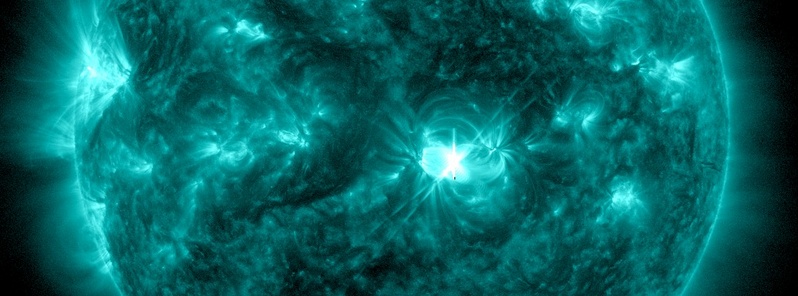Moderately strong M2.1 solar flare erupts from Region 2268

A moderately strong solar flare reaching M2.1 at its peak time erupted from Region 2268 on January 29, 2015. The event started at 11:32, peaked at 11:42 and ended at 11:52 UTC.
As with all the previous M-class flares from this region in the past few days, this latest event had no associated radio signatures that would indicate a Coronal Mass Ejection (CME) was produced.
LASCO coronagraph imagery will be analyzed as data becomes available, SWPC said.
Region 2268 is perfect geoeffective position and Earth-directed CMEs from it are possible in the days ahead.



Sunspots
There are currently 9 numbered sunspot regions on the Earth side of the Sun.
Region 2268 (S10W10, Fkc/beta-gamma) continued to exhibit slight growth in its intermediate spot area, as well as increased separation between the intermediate and trailer spots in the last 24 hours.
Region 2277 (N08E64, Fao/beta-gamma) continued to rotate onto the NE limb, exposing even more spots and an increased area of enhanced plage associated with this region.
Region 2271 (N17W37, Dai/beta-gamma) also showed signs of growth in its leader and intermediate spots as it approaches the western limb.
The other regions on the visible disk remain relatively stable.
New Region 2278 (S09E31, Bxo/beta) was numbered overnight, though it remained fairly inactive.

Sunspots on January 29, 2015. Image credit: NASA SDO/HMI
2268 – Beta-Gamma
2269 – Alpha
2271 – Beta-Gamma
2272 – Alpha
2273 – Beta
2275 – Beta-Gamma
2276 – Beta
2277 – Alpha
2278 – Beta
Forecast
Solar activity is expected to be at low levels with a chance for isolated M-class (R1-R2, Minor-Moderate) flares and a slight chance for R3-Strong activity over the next three days (January 29 – 31). Most of the increased flare activity is likely to originate from Regions 2268 and 2277 as they maintain their large size and complex magnetic structures.
The greater than 2 MeV electron flux at geosynchronous orbit is forecast to be at normal to moderate levels through the same period while the greater than 10 MeV proton flux is expected to remain at or near background levels (Below S1-Minor).
Solar wind parameters are disturbed and are expected to remain like that over the next three days. Additional speed enhancements are possible on January 30 and 31 with solar wind speeds potentially reaching the 450 to 550 km/s range.
Quiet to unsettled levels are expected to continue through the rest of the UTC day. Conditions are then expected to increase on January 30 and 31 to quiet to minor storm levels (NOAA Scale G1) as influence from the southern crown polar coronal hole is expected to increase.

Space Weather Message Code: WATA20
Serial Number: 598
Issue Time: 2015 Jan 28 2021 UTC
WATCH: Geomagnetic Storm Category G1 Predicted
Highest Storm Level Predicted by Day:
Jan 29: None (Below G1) Jan 30: G1 (Minor) Jan 31: G1 (Minor)
THIS SUPERSEDES ANY/ALL PRIOR WATCHES IN EFFECT
NOAA Space Weather Scale descriptions can be found at
www.swpc.noaa.gov/noaa-scales-explanation
Potential Impacts: Area of impact primarily poleward of 60 degrees Geomagnetic Latitude.
Induced Currents - Weak power grid fluctuations can occur.
Spacecraft - Minor impact on satellite operations possible.
Aurora - Aurora may be visible at high latitudes, i.e., northern tier of the U.S. such as northern Michigan and Maine.
Featured image: NASA SDO AIA 131 on January 29, 2015 at 11:42 UTC.

Commenting rules and guidelines
We value the thoughts and opinions of our readers and welcome healthy discussions on our website. In order to maintain a respectful and positive community, we ask that all commenters follow these rules.